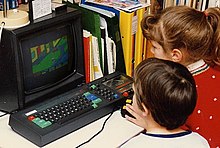Paperboy
| Paperboy | |
|---|---|
| Studio | Atari Games |
| Publisher | Atari Games |
| Senior Developer | John Salwitz, Dave Ralston, Russel Dawe |
| Erstveröffent- lichung |
1984 |
| genre | Skill game |
| Game mode | 2 players take turns |
| control | Bicycle handlebars ; 2 buttons |
| casing | default |
| Arcade system |
Atari System 2 = Main CPU: T11 (@ 10 MHz) Sound CPU: 6502 (@ 1.789772 MHz) Sound chips: YM2151, POKEY , TMS5220 |
| monitor | Raster resolution 512 × 384 (4: 3 horizontal) Color palette: 256 |

Paperboy ( English for newspaper boy ) is a computer game that first appeared in 1984 in the form of a slot machine . Paperboy was one of the first computer games with an isometric perspective . The game character moved diagonally in the game instead of the conventional left-right / up-down movements. The Paperboy slot machine was equipped with a bicycle handlebar instead of a joystick and was the first arcade machine to simulate a bicycle.
Game plot
The game is about the everyday life of an American newspaper boy. The player has to steer the pawn on a BMX bike in a race against time through a place and distribute newspapers. He is prevented by passers-by and biting dogs from throwing as many newspapers as possible in the shortest possible time in the mailboxes of only those subscribers who are on the left side of the street. If a customer does not receive a newspaper or is even thrown a disc, there is a bonus deduction and the subscription is canceled. If all customers receive the newspaper, the result is perfect delivery .
At the end of the road there is a hilly bonus route with water traps. If you fall on the bonus route, neither of the two extra lives are deducted. The first level starts on Monday. The number of obstacles increases with each weekday. The seventh and last level is therefore Sunday. If the player makes it through the seven days of the week, they will receive a headline as a reward.
Ports
The game has been transferred to a few other systems over the years, but for technical reasons the graphics were significantly more pixelated than the arcade version. With the exception of the games for the Game Boy (Mindscape), all published games were produced by Atari Games or their console game division Tengen. The majority of the ports were carried out by Elite Systems , which were also the publisher of the version for the C64 .
In 1991 Paperboy 2 appeared for several popular home computers.
| platform | Porting through | editor | |
|---|---|---|---|
| 1986 | Apple II | ||
| Commodore 64 | Elite Systems | Elite Systems / Mindscape Inc. | |
| Commodore 16 | Kingsoft | Elite Systems | |
| 1987 | ZX Spectrum | Elite Systems | Elite Systems |
| 1988 | DOS | Magpie | Mindscape |
| NES | Elite Systems | Elite Systems | |
| Apple IIgs | Atari Games | Mindscape | |
| 1989 | Commodore Amiga | Elite Systems | Elite Systems |
| Atari ST | Elite Systems | Elite Systems | |
| 1990 | Game Boy | Mindscape | |
| Sega Master System | US gold | ||
| Atari Lynx | Atari Corporation, Tengen | ||
| 1991 | Game Gear | Tiertex Design Studios | Tengen |
| genesis | MotiveTime | Tengen | |
| 1999 | Game Boy Color | GameBrains | |
| Nintendo 64 | High voltage software | Midway | |
| 2007 | Xbox Live Arcade | Digital eclipse | |
| 2009 | Apple iOS | Glu Games Inc. |
reception
| ||||||||||||||
- Commodore 64
In a review written by two editors in Happy Computer , Gregor Neumann found praise for the original gameplay, while Heinrich Lenhardt described it as "extremely mediocre". Both editors criticized the game's graphics, Neumann also criticized the controls.
- Commodore Amiga
The Amiga Joker criticized the detailed, but qualitatively rather mediocre graphics, praised the high level of fun and rated Paperboy as a "successful arcade implementation".
Paperboy in pop culture
Although no new release has been added to the original canon of the Paperboy series for a decade, neither the gameplay nor the paperboy itself has been forgotten. Recently, for example, several games have appeared that consciously took up elements of classic arcade games (e.g. the iOS app Warren Buffett's Paper Wizard or the online game Stickerboy) and references to pop culture were also found in other media.
The most prominent example is the Disney film " Ralph riches ", in which the paperboy has a brief cameo that can also be seen in the official trailer. In addition, the parody musicians of Random Encounters released a "paperboy musical" on iTunes in 2015, the music video of which was viewed over 2 million times.
Web links
- Paperboy in the Killer List of Video Games (English)
- The "Paperboy" series at MobyGames (English)
Individual evidence
- ↑ a b Michael Labiner: Paperboy . In: Amiga Joker . December 1989, p. 57.
- ^ A b Gregor Neumann, Heinrich Lenhardt: Paperboy . In: Happy Computer . Special issue 17, 1987, p. 42.